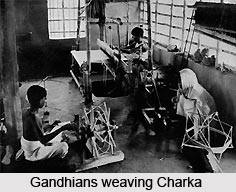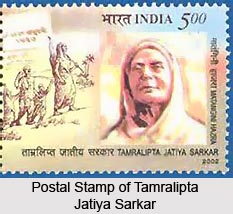Freedom Movement in Medinipur District is the journey of India to attain Independence. East India Company, the foreign trader arrived in this nation with the sole aim of endeavouring their business and luck. But however in the way of time they felt each and every chance in expanding their business in the social turmoil and entered in the political arena of India. Unfortunately, their effort of authoritarianship gained complete success at last. But however their effort was hardly an easy one. From the initial stages only their imperialistic disposition was ruefully hindered by mass movement and revolt from the root.
In 1765, after receiving the `Dewani`, British rulers tried to reform the land system totally. But this was not easy at all. Because 2/3 area of the district was covered with jungle. A large number of Parganas, such as, Barabhum, Panchet, Dampara (now in Purulia), Raipur, Simulpal, Chhatna, Phulkusma (now in Bankura), Dhalbhum and Ghatsila(now in Jharkhand), Bhograi and Jaleswar(now in Orissa) were once annexed to Medinipur district. In later period these regions were known as Junglemahal.
 Many a number of zamindars and local lords, in their own capacities lived in this wide forest region. In Mughal period, they paid taxes rarely. As these places were fringe and infested with ferocious beasts, Mughal rulers remained pleased and did not make any administrative interference. As a result, they ruled their territory almost independently. Every zaminder had some chieftains and under these chieftains some `paiks`(foot soldiers) were appointed. They were not paid any money but were given pieces of agricultural lands freehold or with small range of taxes, as for their honorarium or livelihood. Before the inception of company-raj, this arrangement was in vogue in the north and north-western region of Medinipur district.
Many a number of zamindars and local lords, in their own capacities lived in this wide forest region. In Mughal period, they paid taxes rarely. As these places were fringe and infested with ferocious beasts, Mughal rulers remained pleased and did not make any administrative interference. As a result, they ruled their territory almost independently. Every zaminder had some chieftains and under these chieftains some `paiks`(foot soldiers) were appointed. They were not paid any money but were given pieces of agricultural lands freehold or with small range of taxes, as for their honorarium or livelihood. Before the inception of company-raj, this arrangement was in vogue in the north and north-western region of Medinipur district.
When the British-raj started in this district, these traditional practices were barricaded. Zaminders of Medinipur refused to pay revenues in extended rates. As a result, British resident Mr. Graham sent his chief of force Mr. Ferguson to realize revenues from the disloyal zaminders (1767). In his first attempt, he forced some zaminders to surrender but the stiffest aggression came from the zaminder of Ghatsila. He was able to unify all the zaminders of the surrounding places and started his move towards Ghatsila again in 1778. The whole of Junglemahal set aflame with this revolt. The British authority felt that Jagannath Dhal, zaminder of Ghatsila, was the pivot person of this revolt. So the British Company was forced to requite this zamindary to Jagannath Dhal at Ghatsila in 1777. This unified movement of peasants and zaminders of Junglemahal against British Company was corroborated by the British historian J.C. Price by naming it Chuar Revolt (Chuar Bidroha).
In 1798-99 in the western portion of Medinipur and in the southern portion of Bankura, revolt started in its new phase. This was called the second phase of Chuar Bidroha. Places like Karnagarh, Shiromani, Panchkhuri, Satpati, Salboni, Keshpur, Anandapur, Dhalhara, Dharenda, Ramgarh, Silda, Gopiballvapur, Narajole, Bagri, Chandrakona, Mayna, Jaleswar etc. were the nerve centers of the revolts. Gobardhan Dikpati of Bagri, Rani Shiromani of Karnagargh and Durjan Singh, Zaminder of Raipur, gave the leadership. The British force started utmost torture to suppress this movement. Before the ending of the revolt, tribal peasants started a new movement, which was named `Nayek Revolt of Bagri`(1806-16). In 1816, British ruler got hold of Achal Singha, leader of `Nayek Revolt` treacherously and he was shot dead. His followers numbering almost two hundred were hanged on gallows openly.
In some places, it was found that such type of revolts took a violent approach. As for example, we would like to mention the movement of Malangis. Salt industry was once concentrated in Tamluk and Hijli region. Around 60,000 workers were involved in salt production. After 1760, company took their access in its production and distribution though it brought huge profit for them. But the statuses of salt workers or Malangis were very miserable. In its production work, they had to accept physical suffering, torture and poor wages, but when the situation was unbearable they fled away from the production site. They often protested against this torture or extortion. But the authority never took steps to heal up their grievance. In 1804, one Premananda Sarkar unified the Malangis to set protest against this exploitation. In his leadership, hundreds of Malangis revolted against the establishment of the salt industry. They barricaded the office of the company`s agent in Contai. When Premananda was arrested by the foot soldiers of British, Malangis became more hostile.
 In 1834, a High School for English Education was established. Western influence and its ideologies took access from this school. However, but in the middle of 19th century two renowned persons played significant role to increase national spirit in this district, they are Rajnarayan Basu and Iswarchandra Vidyasagar.
In 1834, a High School for English Education was established. Western influence and its ideologies took access from this school. However, but in the middle of 19th century two renowned persons played significant role to increase national spirit in this district, they are Rajnarayan Basu and Iswarchandra Vidyasagar.
Rajnarayan Basu came to Medinipur in 1851, as the Headmaster of the Government Zilla School (Collegiate School of today`s) and he kept his chair until 1866. In his staying at Medinipur apart from developing his school, he established various types of organizations relating to education, ethical life, physical practice and national consciousness. Among these organisations, re-establishment of Brahma Samaj, establishment of Jatiya Gourav Sampadani Sabha, Surpan Nivanai Saha, Girls` School, General Library etc. are worthy of mention.
Ishwar chandra Vidyasagar is a great son of Medinipur district. He was a philanthropist and social reformer. He even contributed Bengali prose in its making and achieving literary status. He practiced literature with a part of his social work. He wrote Bengali primus like Barnaparichaya-I & II, Kathamala and Bodhodaya etc. He stressed upon vernacular to mediate education. He was an Inspector of Special English Schools of Nadia, Hooghly, Bardhaman district and Medinipur. He took great steps for mass education of this district. But in a colonial state, this venture did not achieve expected target. Finally, he resigned his post just three years after his appointment. In 1853, he established an English-Sanskrit school in his native village Birsingha. He also realized that this country would not go ahead without stressing on Girl`s education. From November 1857 to May 1858, he established 35 Girls` School in different districts of Bengal. Among them three schools were established in Medinipur district. For his utmost effort and movement on 26th July 1856, remarriage of Hindu widows was legitimated. He took several steps in social reformation.
Regarding tenancy rights after establishing Bharat Sabha in Medinipur, Ghatal, Contai and Ramjibanpur, another 29 branches were opened. These were called `Rayat Sabha`(tenant`s committee). Its main purpose was to establish tenant`s right on lands. Bharat Sabha took several schedules to boost up political activities in this districts which involved many persons.
In 1885 Indian National Congress was established and Indian politics took a new way. From the very beginning, this district made its link with Indian Congress. In the Annual Conferences of Congress, delegates of this district took their part regularly. Among them eminent persons are Jogesh Chandra Roy at Tara, who was a reputed lawyer, Kartick Chandra Mitra and Bipin Behari Dutta etc. In the last decade of 19th century protest was organized against the Indigo Plantation, which was called `Gochar Movement`. In 1901, State Conference of Congress was held, which created enthusiasm in this district.
In the early days of 20th century Medinipur became the nerve centre of extremist and freedom fighters. This influence was contributed by Sri Aravinda, grand son of Rajnarayan Basu. In 1902, he resigned his service at Baroda state and came to Medinipur and formed a patriotic organization with Hemchandra Kanungo, Gnanendranath Basu and Satyendranath Basu. In 1903, Sister Nivedita , the great woman and follower of Swami Vivekananda, came to Medinipur. She cited for spiritualism and inspired the youth in Nationalism. She even stressed upon ethical and physical upliftment and established `akhra`(gymnasium).






